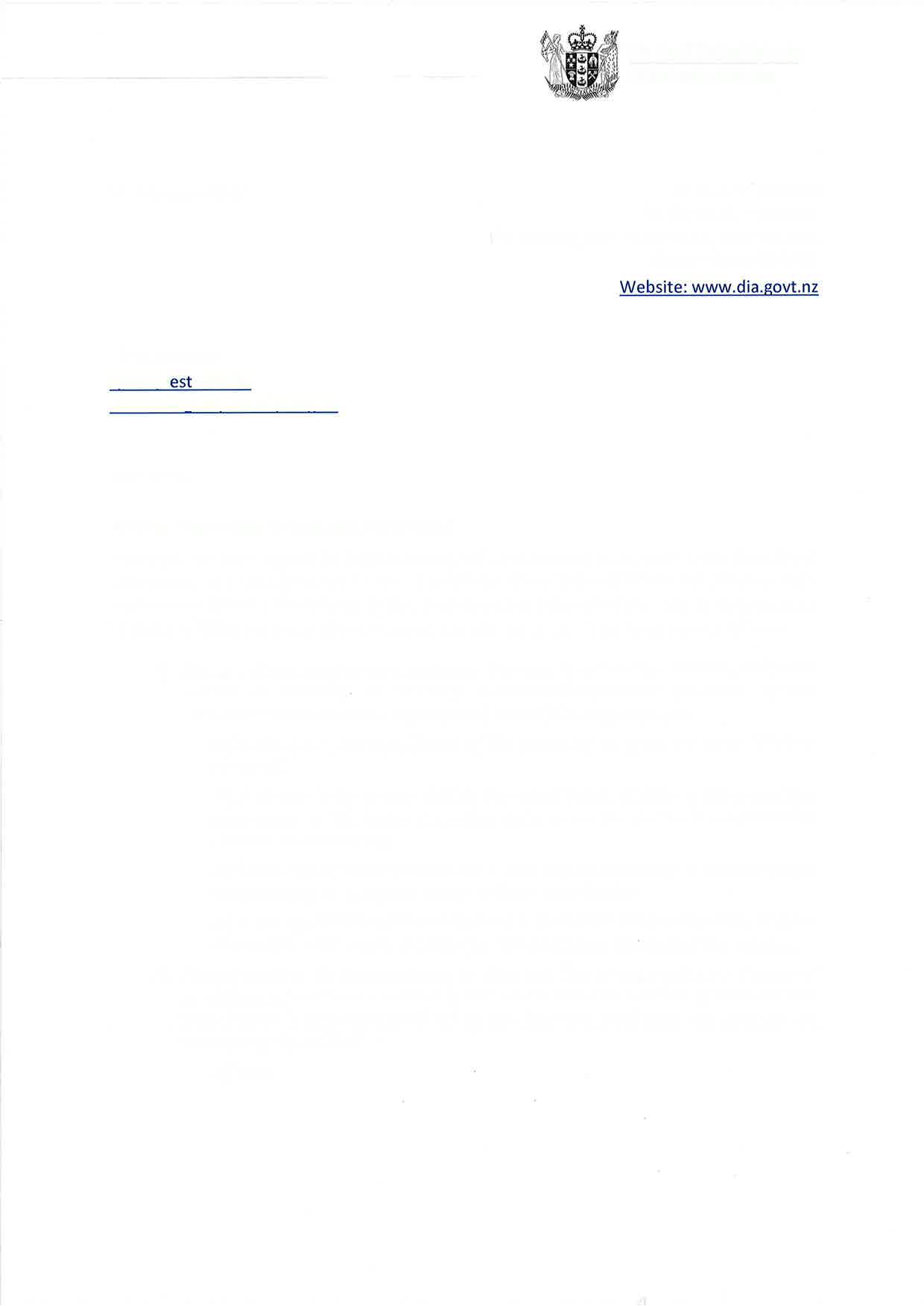
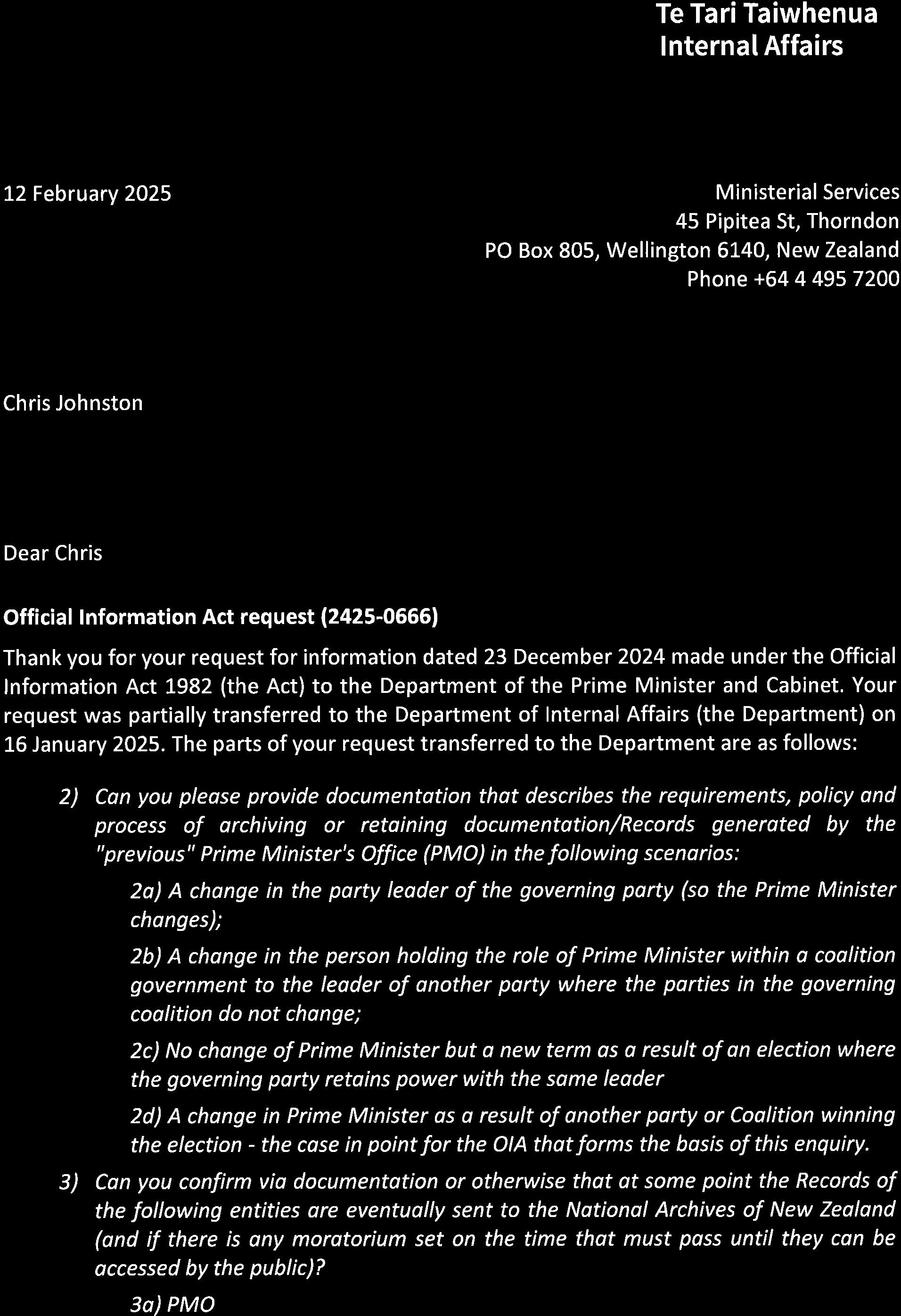


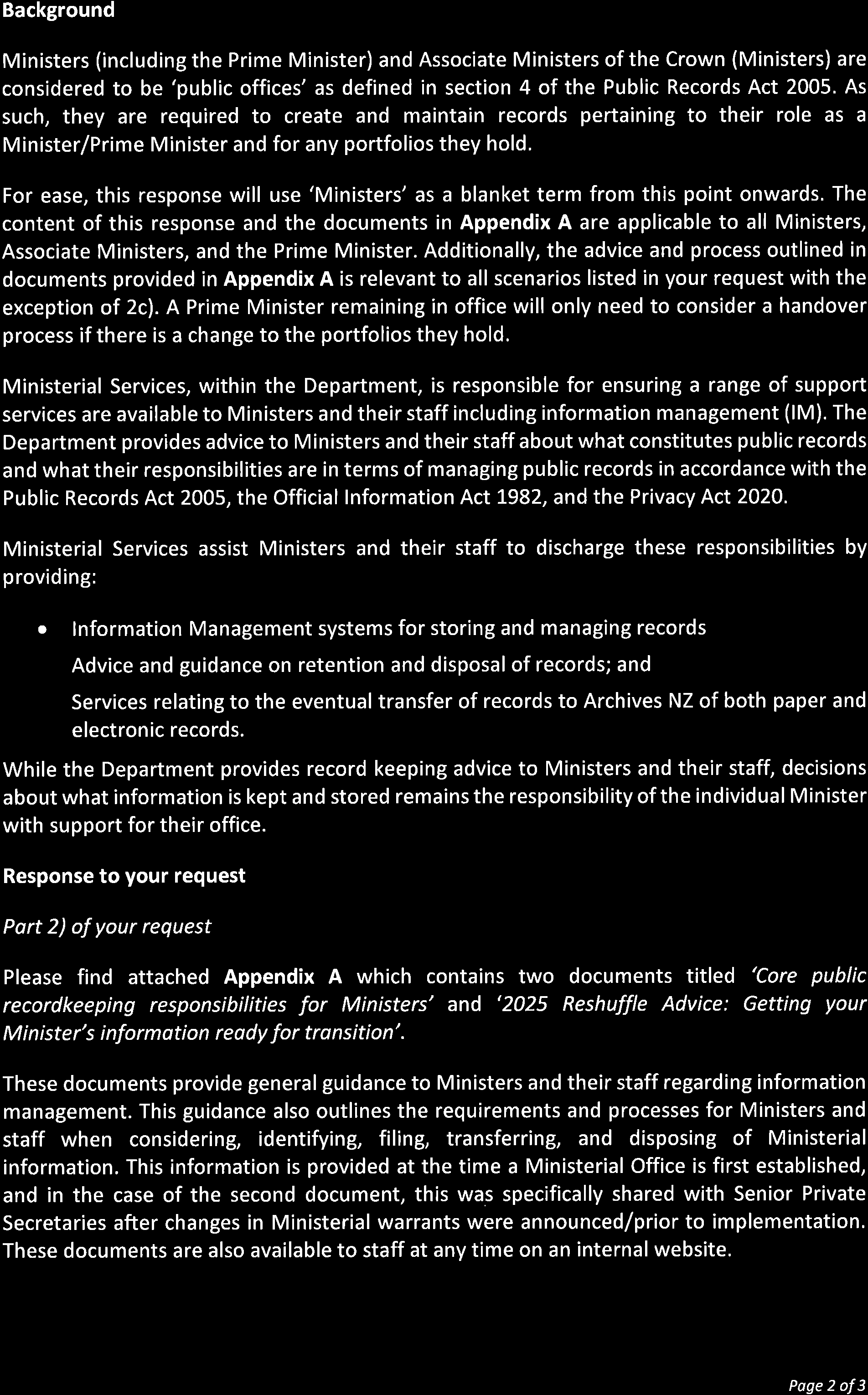
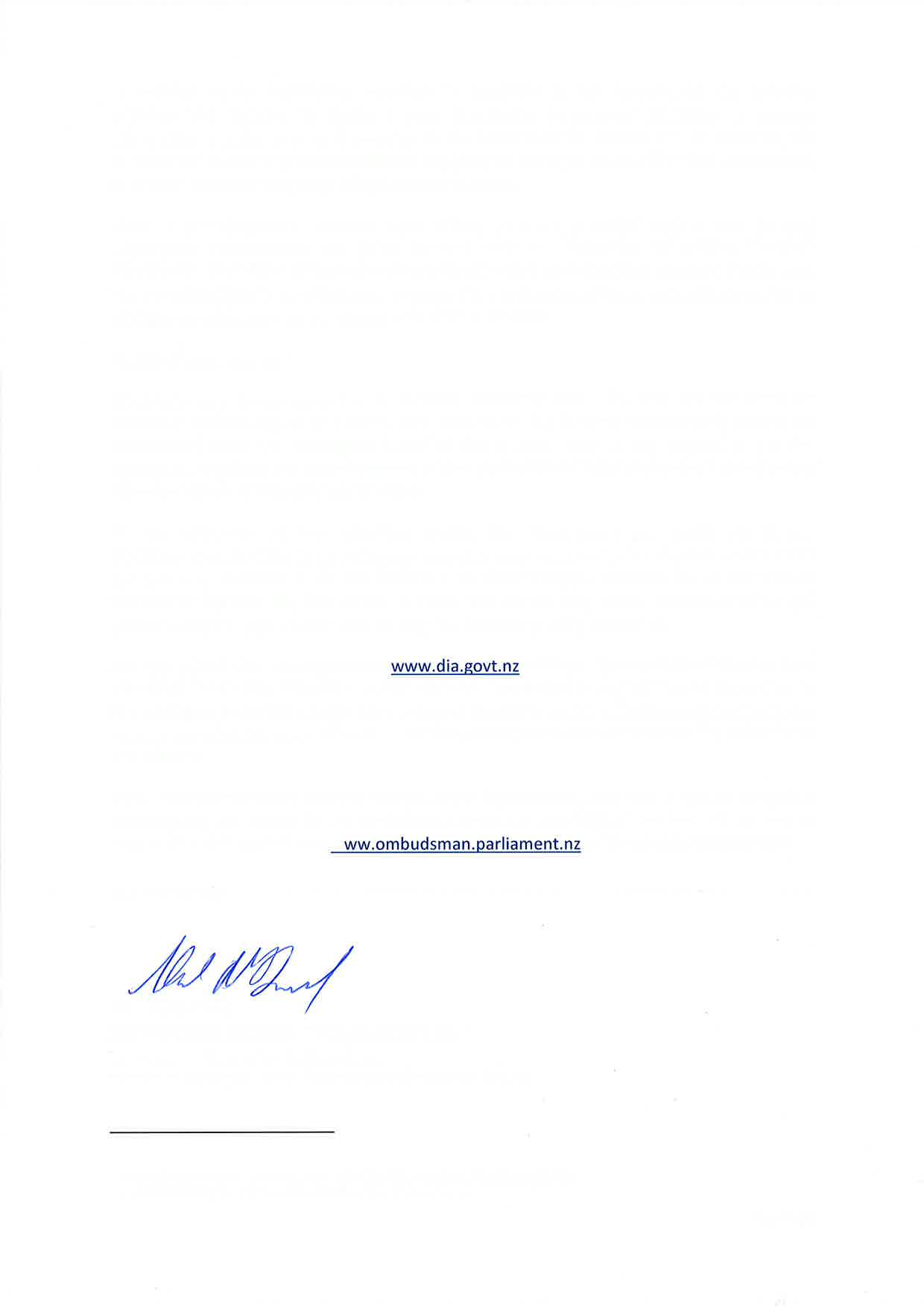
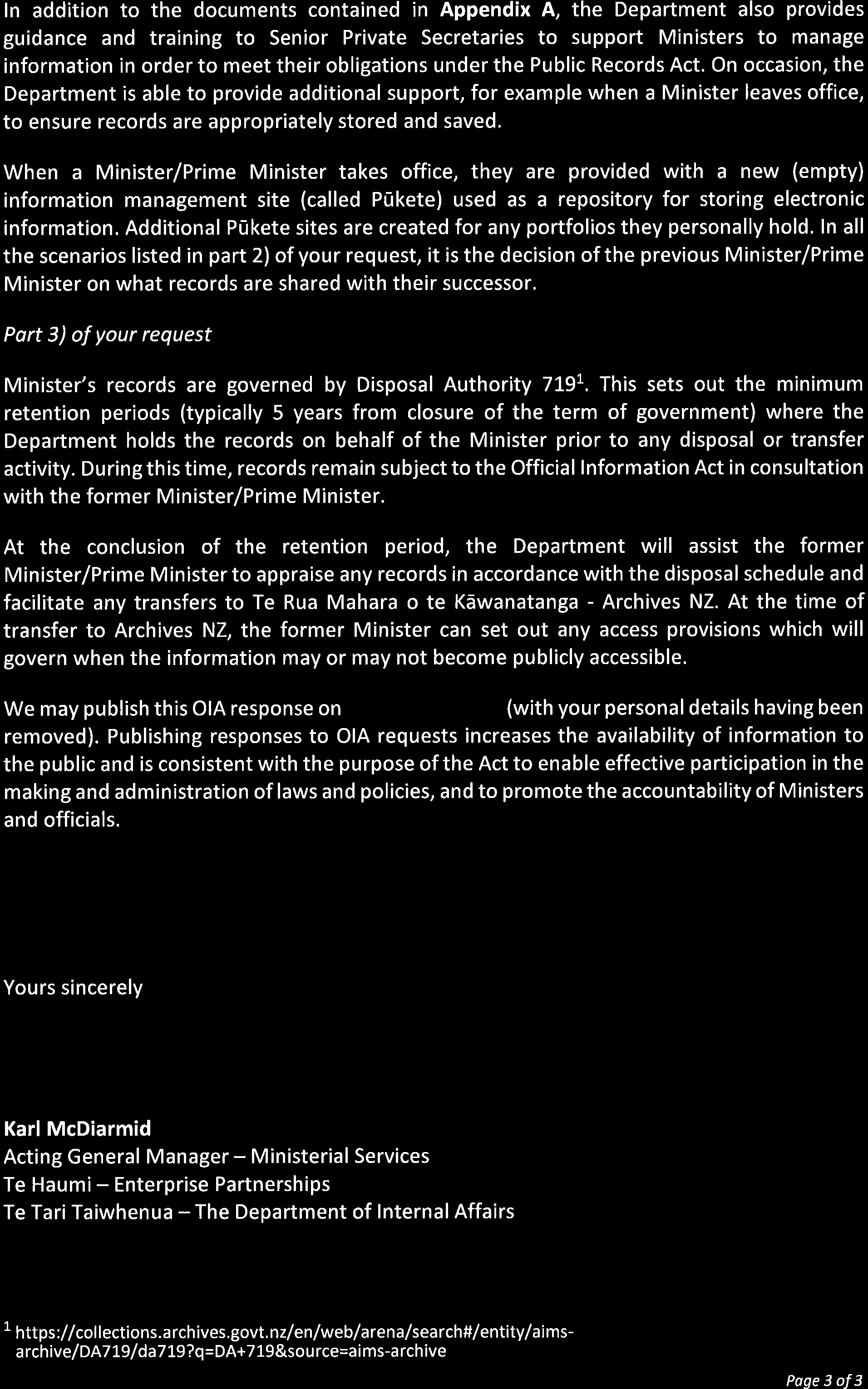


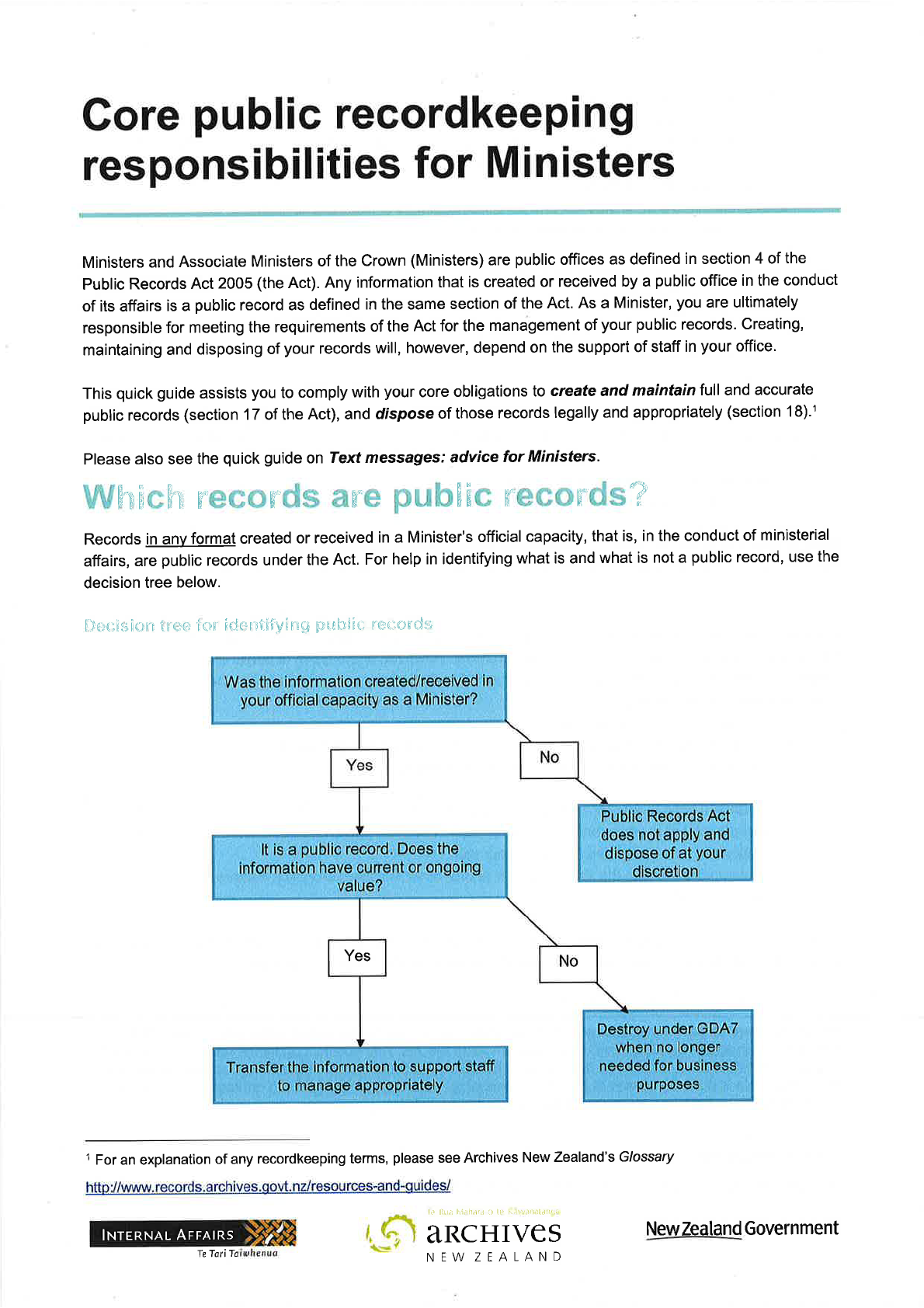
Appendix A
1982
Act
Information
Official
the
under
Released
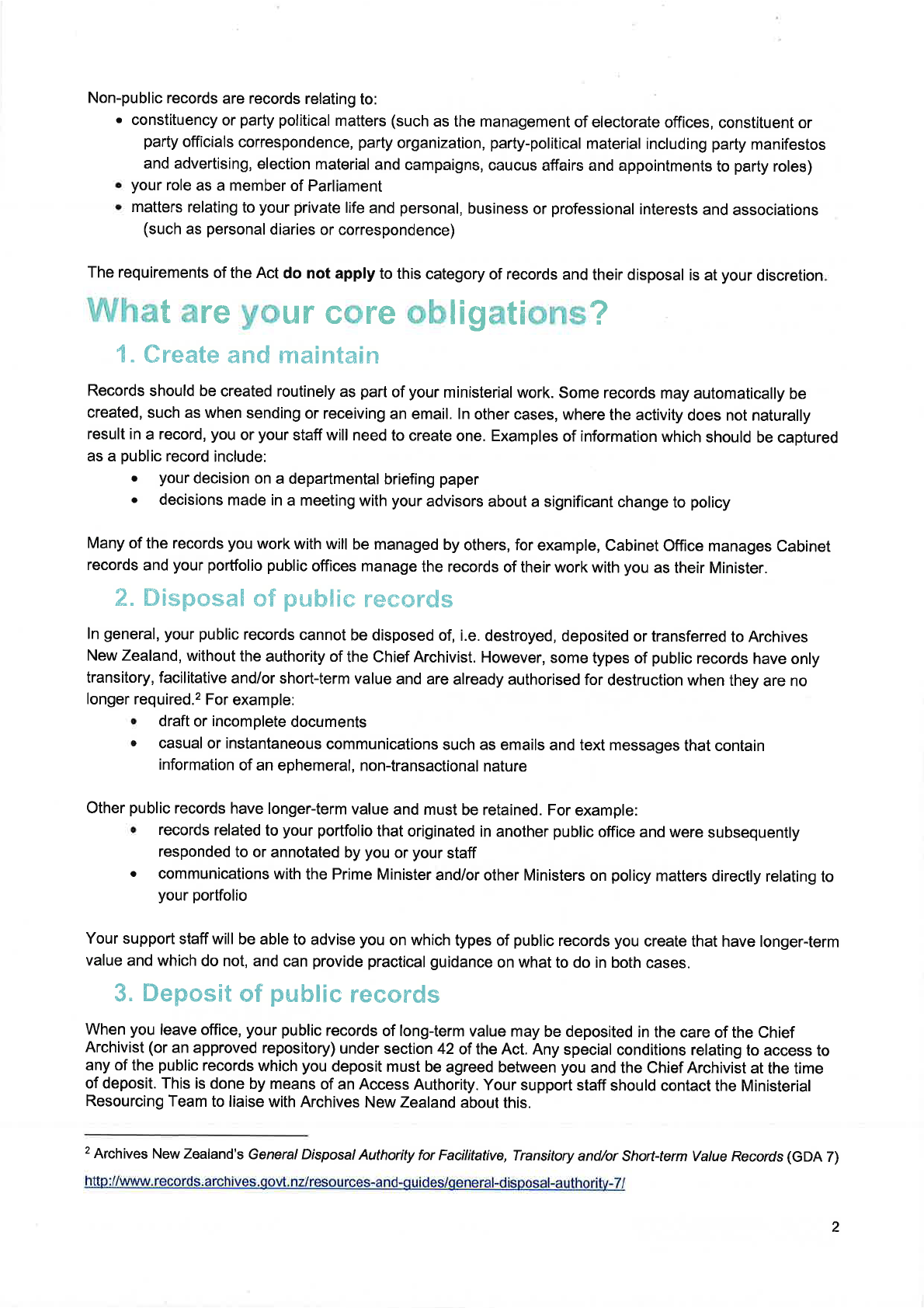
1982
Act
Information
Official
the
under
Released
 UNCLASSIFIED
UNCLASSIFIED
1982
2025 Reshuffle Advice:
Act
Getting your Minister’s information
ready for transition
Information
A guide for Senior Private Secretaries
Official
the
under
Released
Version date: January 2025
Ministerial Resourcing
Ministerial Services
 UNCLASSIFIED
UNCLASSIFIED
Contents
SECTION 1 - Introduction ........................................................................................... 3
What you need to consider ........................................................................................ 3
What the Public Records Act requires ....................................................................... 3
What you need to do ................................................................................................. 4
SECTION 2 – Action plan ............................................................................................ 4
Step 1: Initial preparations – consider and identify ................................................... 4
1982
Step 2: Categorise and move ..................................................................................... 5
TABLE 1: INFORMATION TO KEEP FOR SUBSEQUENT TRANSFER TO ARCHIVES
Act
NEW ZEALAND .................................................................................................. 5
TABLE 2: INFORMATION TO MARK FOR FUTURE DELETION ............................ 6
TABLE 3: INFORMATION TO DESTROY .............................................................. 7
Step 3: List physical information ................................................................................ 8
Step 4: Box physical information ............................................................................... 8
Step 5: Destroy information ....................................................................................... 9
Appendix A – Frequently Asked Questions .............................................................. 10
Why does it matter? .......................................................................................
Information 10
What happens to the information once a Minister moves on? ..................... 10
What happens to the Pūkete sites and folders the Minister and their office
staff have been using? .................................................................................... 10
How long does a Minister’s information need to be kept? What is a disposal
authority? ....................................................................................................... 11
Official
Appendix B – Ministerial Records Listing Schedule Template ................................... 12
the
DA719 Disposal
Schedule.pdf
....................................................................................................... 12
under
Released
UNCLASSIFIED
Page 2 of 12
UNCLASSIFIED
SECTION 1 - Introduction
Ministers’ information needs to be appropriately managed at all times in the lead up to, and
following, the General Election and during transitions between offices.
As a Senior Private Secretary (SPS) you will need to determine what information can be
deleted or destroyed, and what needs to be kept and stored. Your Minister wil need to be
involved in some of these decisions.
1982
This guide wil help you to support your Minister to meet their obligations under the Public
Records Act 2005 (PRA), Privacy Act 2020 and Official Information Act 1982 (OIA) and Act
outlines the steps you wil need to follow. Additional guidance is available if you need it -
please contact your Portfolio Manager in the first instance.
Your goal is to have your Minister’s information in a ready state at all times, so that you and
your Minister are well prepared for any transition period. Please note
information and
records are used interchangeably in this guide. The guide also refers to
Destroy. Destroy
covers both the
destruction of physical information and the
deletion of digital information.
What you need to consider
Information
Ministers have multiple roles. In addition to being part of the Executive, they are also a
Member of Parliament, party member and private citizen.
Information your Minister (and their office) receives or creates in their Ministerial capacity is
covered by the PRA, Privacy Act and OIA. There are specific requirements that need to be
Official
met. Your Minister is personal y responsible for meeting these obligations.
Information your Minister receives in their capacity as a Member of Parliament, party
the
member or private citizen is not subject to the PRA or OIA. The Minister can decide what
happens to this information. Where this information contains personal information about
others, the Minister is stil subject to the Privacy Act.
What the Public Recor
under
ds Act requires
The PRA defines a public record as ‘any information that is created or received by a public
office in the conduct of its affairs’. The Act requires that Ministers:
• Create full and accurate records in accordance with normal, prudent business
practice, and organise and maintain them in accessible form for as long as they are
required; and
Released
• Dispose of these records legally and appropriately when no longer required. The
disposal of records must be authorised by the Chief Archivist via a Disposal Authority,
and usually entails either destruction or transfer to Archives New Zealand.
UNCLASSIFIED
Page 3 of 12
UNCLASSIFIED
Note:
Disposal authorities are approved by the Chief Archivist. There are different disposal
authorities covering different classes (categories) of information. The tables within Section 2
below will act as a guide and are based on the Ministers’ Disposal Authority (DA719) as well
as the applicable General Disposal Authorities that apply to all public records. If you require
detailed guidance, Information Management staff are available to assist you, please talk to
your Portfolio Manager in the first instance.
1982
What you need to do
1.
Consider what information is held by you and your staff and where the information
Act
currently resides.
2.
Identify,
in consultation with your Minister, what action needs to be taken with that
information in accordance with the instructions provided,
e.g., destroy, store, transfer to
a new Minister or return to the originating agency.
3.
File the information based on the instructions provided, i.e., ensure all content relevant
to the portfolio and the Minister’s role are stored into the correct Pūkete site/library.
Ensure staff who may have content in their One Drive or desktop locations have filed this
Information
content appropriately
4.
Box-up physical (paper) information which needs to be stored. Include a contents list
created using the supplied template – see Appendix B.
5.
Destroy information which does not need to be kept (note this is quite a small subset of
the information and if in doubt consult with the DIA Information Management staff.
Official
the
SECTION 2 – Action plan
Step 1: Initial preparations – consider and identify
under
Identify al the information held in your office, including on people’s work phones, on One
Drive, in email accounts, social media and messaging apps, or stored in cabinets and
cupboards etc.
Ask staff in your office to tidy up their personal drives (OneDrave) and email accounts in
preparation for the next step:
Released
• Delete any duplicated information (including print outs of digital information).
• Move any portfolio or other official information stored in other locations to the
appropriate folder in Pūkete.
UNCLASSIFIED
Page 4 of 12
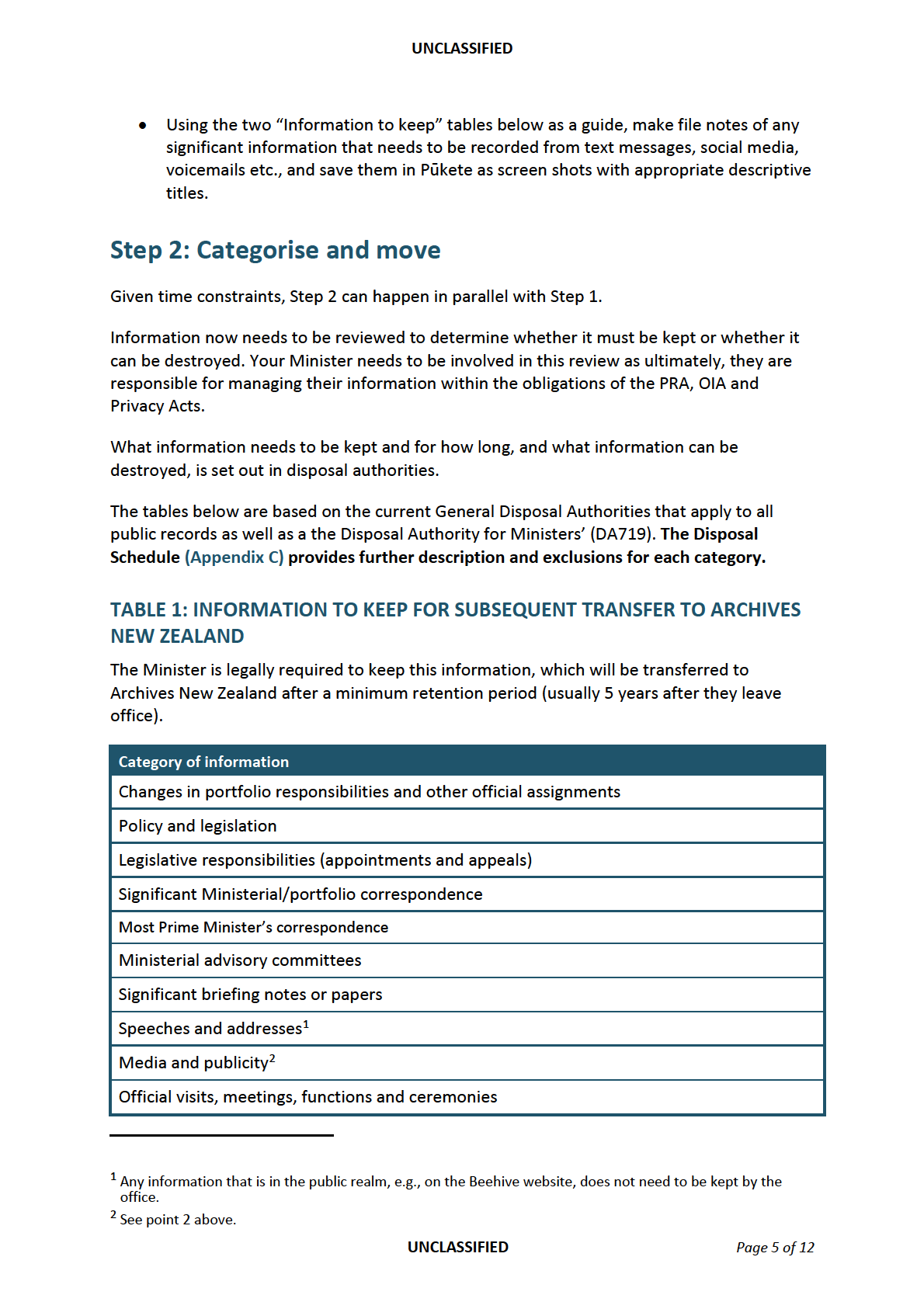
1982
Act
Information
Official
the
under
Released
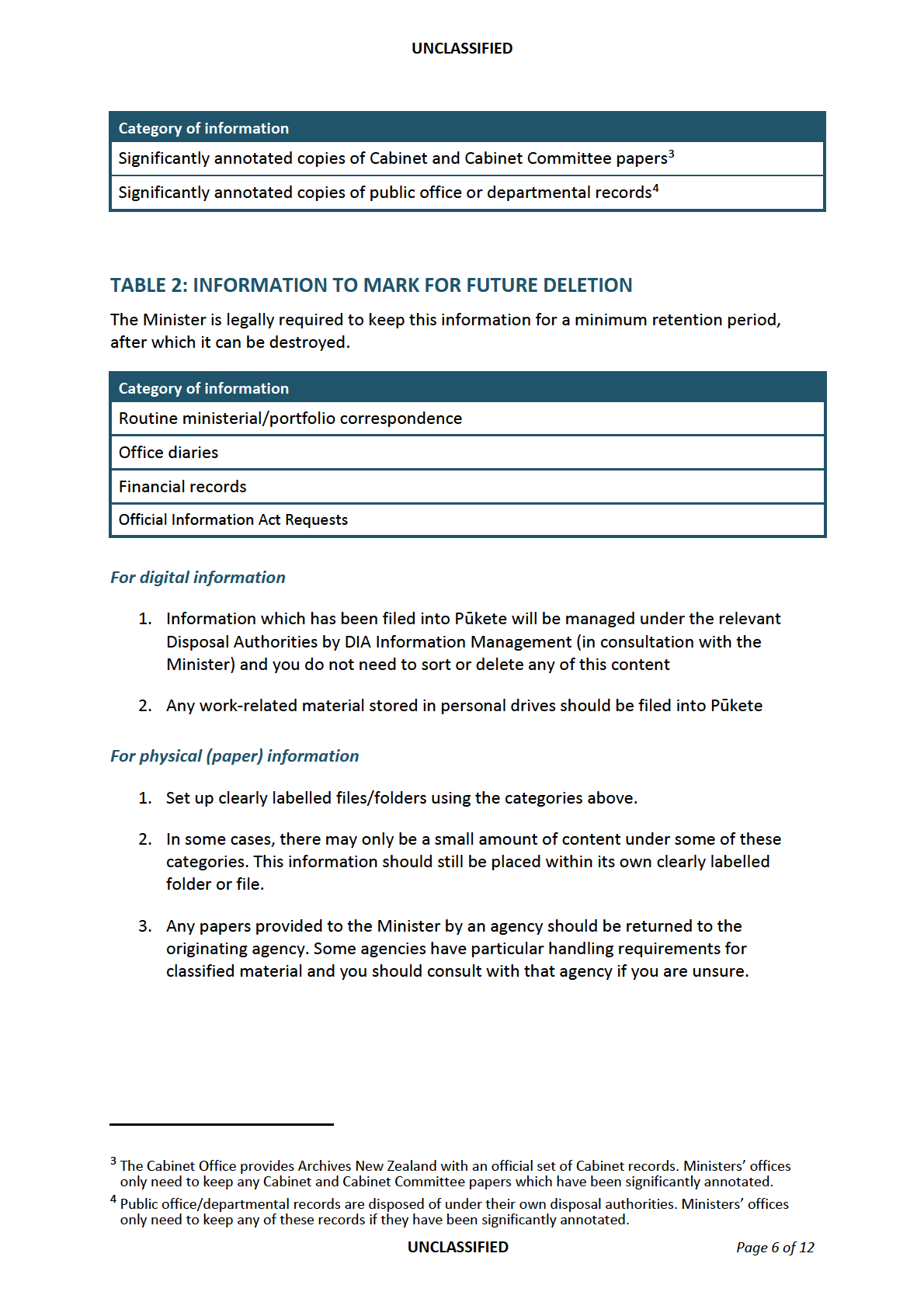
1982
Act
Information
Official
the
under
Released
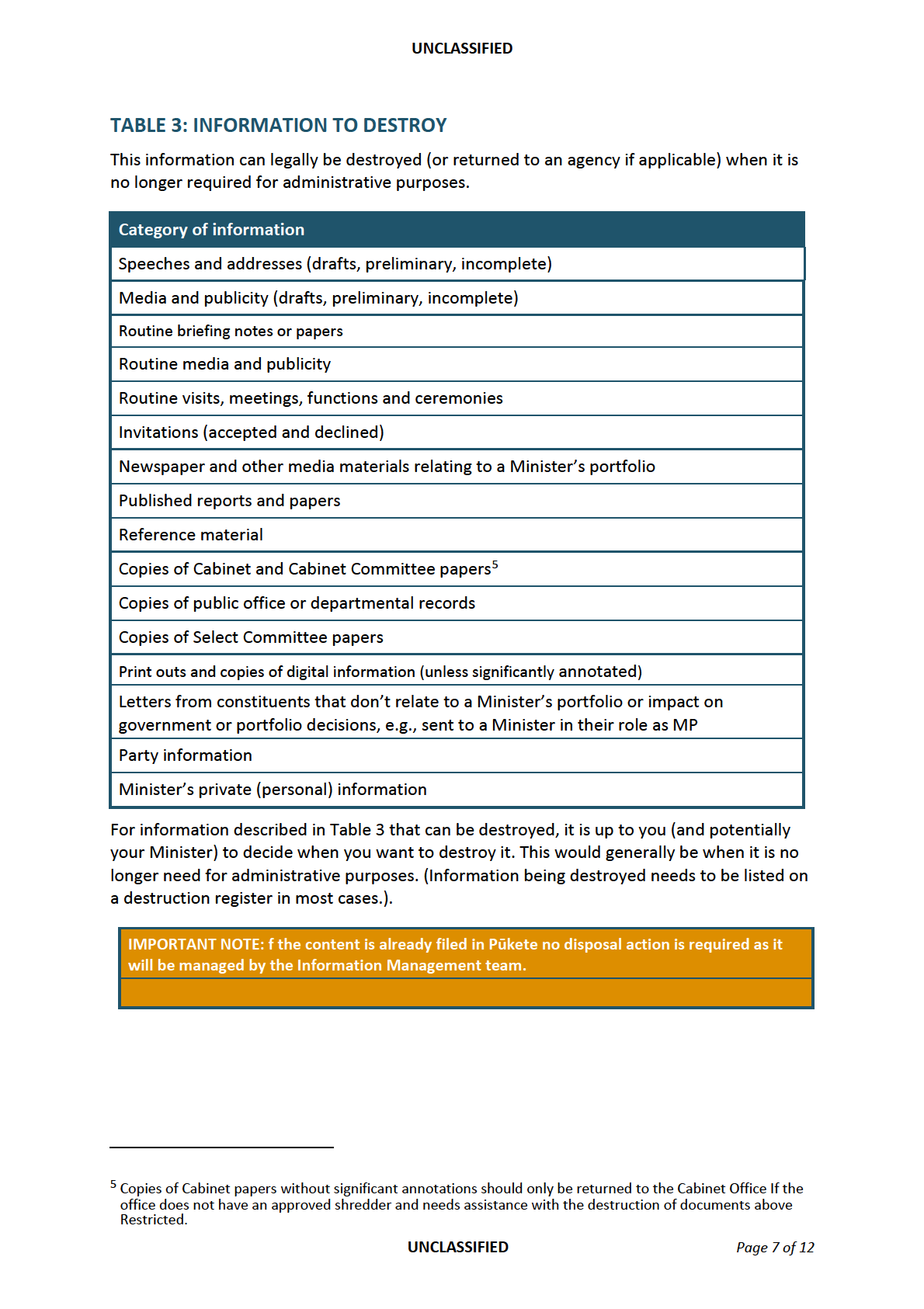
1982
Act
Information
Official
the
under
Released
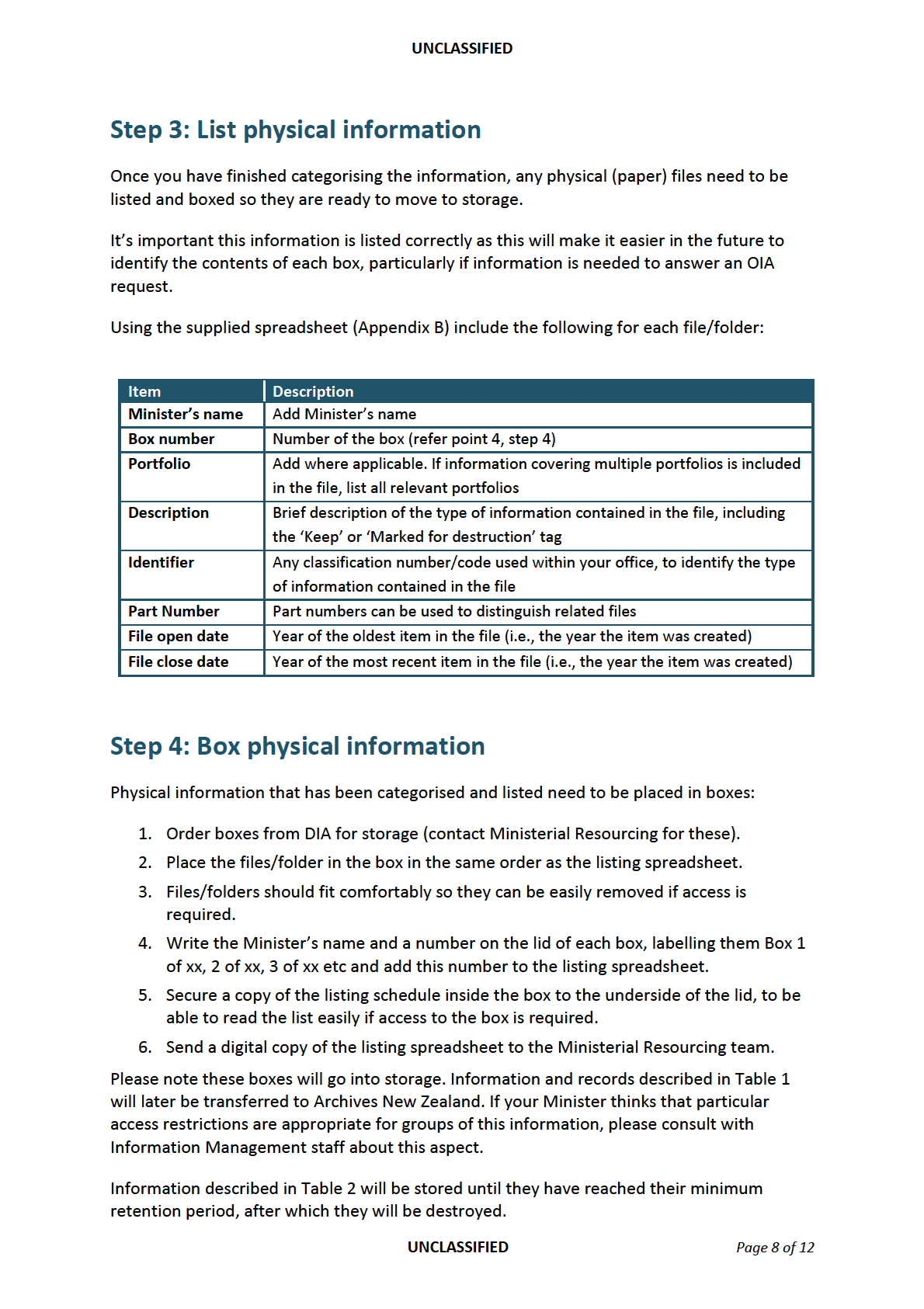
1982
Act
Information
Official
the
under
Released
UNCLASSIFIED
Step 5: Destroy information
When disposing of physical information that can be destroyed immediately (e.g. print outs
and copies):
• For information classified SENSITIVE or RESTRICTED, or above, use the NZSIS
approved shredder (grade 3) in your office.
• Information classified as UNCLASSIFIED or IN-CONFIDENCE, should be disposed of in
the secure bin in your office.
1982
Act
Information
Official
the
under
Released
UNCLASSIFIED
Page 9 of 12
UNCLASSIFIED
Appendix A – Frequently Asked Questions
Why does it matter?
Information from Ministers’ offices forms part of the public record, as well as capturing a
Minister’s legacy and their part in the history of New Zealand. This information tells us what,
where, when and why business activities occurred. It shows the context of decisions and
under what authority they were made, and provides evidence of Government and public
1982
office business activity.
The PRA requires Ministers, in simple terms, to keep a record of their advice, actions and
Act
decisions. It doesn’t matter how this information has been communicated, e.g.., by text,
email, social media, paper etc., the important thing is that the information needs to be
captured and managed appropriately.
What happens to the information once a Minister moves on?
Ministers have discretion over what information is passed to their successor. They may
choose to make some, or all, of this information available. Ministerial Services will generally
facilitate any information transfer.
Information
In the case of a change in Government following an election, information created or received
by the previous Government may be made available to the Government of the day but only
at the Ministers’ discretion.
What happens to the Pūkete sites and folders the Minister and their office
Official
staff have been using?
As a general rule:
the
•
Ministerial staff will lose access to the Minister’s Pūkete site and Ministerial
Outlook folders when they no longer work for that Minister, or when a Minister of
former Minister departs Parliament, or when their Minister is no longer a Minister.
•
Ministers will retain access to their personal H drive, their Pūkete site and their
under
Ministerial Outlook folders until such time as they leave Parliament.
•
Ministers and their staff will continue to have access to their own personal drive
for as long as they are in Parliament.
The outgoing Minister can approve a copy of Portfolio related information to be passed to
their successor. They retain the original information.
Released
UNCLASSIFIED
Page 10 of 12
UNCLASSIFIED
How long does a Minister’s information need to be kept? What is a disposal
authority?
This is determined by a set of rules set out in a disposal authority, which is issued by the
Chief Archivist. A disposal authority lists the different categories of information which
Ministers are likely to create or receive in their role, how long this information needs to be
kept for, and what happens to it after a specified period.
For information that can be destroyed, each office can decide how long it needs to be kept. 1982
Offices should consider factors such as their Minister’s preferences and how likely it is that
the information will need to be referred to again. The ministerial information that needs to
be retained will initially be stored for at least five years, then may be deposited with Act
Archives New Zealand.
Any special conditions relating to public access to these records must be agreed at time of
deposit. This is done by means of an access authority and wil be facilitated by Ministerial
Services and Archives New Zealand.
The Disposal Schedule for Ministers, Associate Ministers and Parliamentary Under-
Secretaries - physical and digital records (DA 719) governs all Ministerial records
See also Archives New Zealand advice on General Disposal Authorities: General disposal
Information
authorities – Archives New Zealand
Official
the
under
Released
UNCLASSIFIED
Page 11 of 12

 UNCLASSIFIED
Appendix B – Ministerial Records Listing
Schedule Template
UNCLASSIFIED
Appendix B – Ministerial Records Listing
Schedule Template
Ministerial Records
Listing Schedule Temp
1982
Appendix C –
Disposal Schedule for Ministers, Associate Ministers and Parliamentary Under-
Act
Secretaries - physical and digital records
DA719 Disposal
Schedule.pdf
Information
Official
the
under
Released
UNCLASSIFIED
Page 12 of 12
Document Outline


















